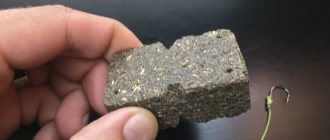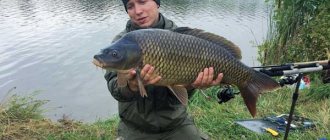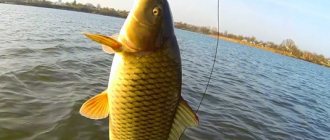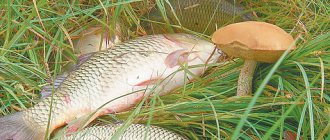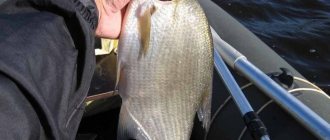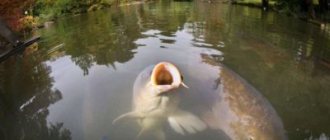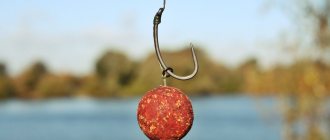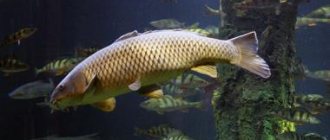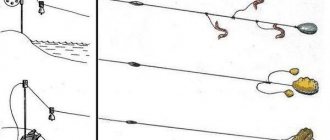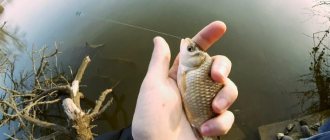Alexander Fedorov aka Hot Demon has achieved impressive results in trophy carp fishing in wild reservoirs. In this article, he shares his secrets in the field of tactics, bait, equipment and choice of fishing location.
Good day, dear readers, colleagues, comrades-in-arms! In this article I want to discuss with you a special type of fishing, the constant attributes of which are luck, patience, thinking, perseverance and, of course, silence! This is fishing for Wild Trophy Carp.
When I was still a schoolboy, my parents took me during the summer holidays to a village, on the outskirts of which there was a small pond. It was there that my first acquaintance with fishing happened.
At that time, I took great pleasure in catching small crucian carp using a bamboo fishing rod with a goose feather float. I couldn’t even imagine that at that time I would be lucky enough to experience all the delights of a battle with a mighty trophy carp. Of course, it was lost... The float going into the abyss, the trembling in my hands, the sound of the tearing fishing line and the final somersault of the handsome man rushing to freedom - I remember all this as if it were yesterday.
Time passed, years flew by. I am no longer that carefree boy who ran to the shore every morning to fish. Already my own child asks me a question: “Dad, when will you take me fishing?” With trepidation, I tell them my stories, in which I make sure to teach them to take care of nature and all living things, as my father once taught me.
But I’m sure that it was that incident on the lake, which remained in my memory forever, that was the beginning of my favorite hobby - carp fishing!
I grew up, spent a lot of time on reservoirs and went through everything: Neva reels, titanium spinning rods, all kinds of baits from porridge to a worm. In 2010, I became interested in modern carp fishing, read magazines, and watched educational videos ten times with great interest. By the will of fate, I was able to meet wonderful people, great masters of their craft in the person of Alexander Nosovets and the friendly team of the Carptime store, whose consultants I am grateful to this day for their useful advice.
On this, with your permission, let me finish my little excursion about how it all began, and move on to the questions that I often asked myself in my “carp” life and what answers I managed to find for them.
Choosing a reservoir
One of the very important points in trophy fishing. Therefore, I begin with a discussion of this topic. Let me just say: communicate with people without hesitation, communication is golden! I learned about many excellent reservoirs from friendly conversations with the local population on my fishing trips.

I always take a second guest chair with me during sessions. Residents of nearby villages share with me very important and interesting information over a cup of strong tea with great pleasure. It is very important to be able to carry on a conversation with spinners: for me they are the eyes and ears of rivers and lakes. Modern means of communication, Yandex maps, fishing forums - very often not carp - provide a lot of interesting things for our direction. I always try to collect as much information as possible from all of the above sources about a new body of water where I plan to go fishing.
Studying the reservoir, choosing promising fishing spots
The process for me is always long and very interesting. If time and location of the reservoir allows, then I try not to miss the opportunity to visit it on the eve of the session and draw up a map of the entire reservoir - in detail! Of course, if the scale of the water allows. The best assistant for this is a good echo sounder and a quick-assembly boat. Don’t be too lazy to study the place you like using a marker - even after sonar, I’m sure you’ll learn a lot of interesting things.

As a rule, the places that come into my field of vision are natural hiding places for fish: snags, reeds, islands of vegetation, as well as uneven terrain - edges, exits from pits, so-called navels, various changes in the structure of the bottom. One of the preferred places for placing rigs is thickets of grass and reeds opposite the fishing shore. The depth there is usually shallow and the bottom is hard. They say about such places: “Place it quietly under the opposite reed.” As a rule, I make two points that I feed, and send one rod for constant search. If the distance allows, I cast, then I cast a boat with a small bait bunker. I use stationary markers, and if landmarks allow, I prefer to do without them.
Description of the reservoir
The paid reservoir, as an object of management of the Wild Carp club, is a huge lake in the forest: length 1400 m, width 100 m, depth reaches 6 m and the working surface area is 8 hectares.
By its nature, a reservoir is a water area with intense water exchange, which has a positive effect on the life of its aquatic inhabitants (it is saturated with oxygen and has a clean habitat).
The location of the reservoir is quite convenient, just 30 minutes away from the Moscow Ring Road. Having spent only one hour, fishing lovers living in the South-West, South and South-East of Moscow can enjoy the silence among birch and spruce trees, and, most importantly, use their skills in catching a large specimen.
Nozzle and bait
A topic of debate for all fishermen, which lasts for many years and intensifies every year, as new players enter the carp food market!

I am constant on this issue. Throughout the entire time I have been fishing for carp with boilies, I have been using Richworth products. Everyone has their own choice - I’m just confident in these boilies and they serve as my faithful assistant in fishing, but what else does an angler need to be happy? In most cases, I fish with a small bait of 10-14 mm of neutral buoyancy, often using corn - a natural grain in tandem with a floating one. Lately my nozzle has been dominated by fruity scents. But this, as they say, is my choice. I use a maximum of 2-3 flavors per session. I dip bait boilies. For cold water for a long time - 4-6 hours, for warm water - from 20 minutes to 1 hour. In practice, there are many reservoirs where I don’t use deepening.
Preparation of bait
The success of catching wild carp directly depends on the correct combination of ingredients and preparation of the mixture. Experienced fishermen recommend feeding promising waters several days before fishing, if possible. This will increase the likelihood of a good bite, because... the fish will begin to accumulate en masse at the feeding point and will constantly return back for a new portion of nutritious food.
To prevent the bait from being carried away by the current, it must contain clay, which can be found directly on the river bank. It not only makes the mixture heavier, but also makes it uninteresting for small fish.
The key components of bait can be pearl barley and millet. But you shouldn't cook it over fire. Instead, the porridge is poured with boiling water and steamed in order to maintain hardness, ensuring that small fish are cut off.
The use of bulk mixtures is not justified, because... they will be quickly washed out by water and will not be able to hold the fish in one spot. The steamed grain is mixed with clay in a ratio of 1/1. Then, based on the composition, small balls are molded and thrown into selected places. Feeding is best done from a swimming device or using a special slingshot.
To enhance the attractive aroma of the mixture, it can be diluted with corn CSL, which has a natural and attractive aroma. It is also possible to use beet molasses, which creates a cloudy cloud in the water.
Good feeding ensures long-term retention of carp in one water horizon.
Lure
In the summer, when the fish are active, I often start feeding them grains: corn + hemp. This is done to create movement for any white fish on the bottom. I think this arouses the interest of our inquisitive carp. I always make sure that a large faction is present at the point. Usually these are boilies scattered throughout the swim, halves and quarters, which are difficult to destroy by weed fish. On the second day, I reduce the amount of grain in the bait and switch to pellets and boilies. The composition of the bait depends on the time of year and water temperature. For cold water, I readily use instant pellets and a small amount of cut boilies, hemp, bulk bait and amino complexes, as well as liquid additives with strong fruity and pungent odors. I exclude corn in cold water! In warm water, when the fish are active, I use grains, fatty pellets, boilies, liquid additives, and fish oils as bait.
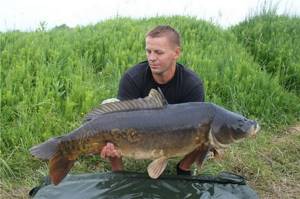
The size of the bait spot depends on the fishing conditions. If space allows, then, as a rule, five by five meters. I fish at a distance of three to ten meters away from the spot, assuming the most successful approaches of the fish. I feed using a boat, if distance allows - I’m not too lazy to go around the pond and use the feeding bucket with minimal noise.
What to feed wild carp
Reservoirs where wild carp live are common. In terms of behavior, wild carp are naturally very different from their “domesticated” counterparts. Nevertheless, they feed well and are voracious, although not all bait is accepted. Now there is a huge selection of baits and flavors, but wild carp from central Russia differ in their tastes from wild carp of “international standards”. The experience of experienced fishermen shows that Russian wild carp respond best to bait that is not very odorous, dark and consisting of small particles - that is, similar to what they eat every day in their pond. Here is a sample recipe: 2 kg of Dutch feeder bait, 500 g of roasted hemp, 250 ml of liquid copra, 250 g of additive for “white” fish, 1 kg of “Super Cup” bait.
When all this has been turned into a homogeneous mixture, you need to paint it in a natural color - for example, brown, using Magic Color paint. When the mixture is moistened and infused, it needs to be sifted twice. To make it “alive”, you need to add a liter of live maggots and two to three kilograms of small live bloodworms. Wild carp love bloodworms, and they must be alive for the fish to notice how they move. The small fish swim in first, and the larger ones follow.
Tackle, leashes, equipment
I tried a huge number of different montages. When creating my leashes, I am guided by the proverb: “Everything ingenious is simple.” This is an ordinary leash made of soft material or soft braided material. Length – 16-20 cm. It can be longer: it depends on the fishing conditions. Installation – “inline” or classic with a safe clip and side weight. It depends on the fishing distance. I pay great attention to the hook. I usually use #4 hooks. Before each cast I check the sharpness of the hook, the slightest suspicion - I immediately change it to a new one! It’s very difficult psychologically to experience gatherings, since you wait for that one bite for many days.
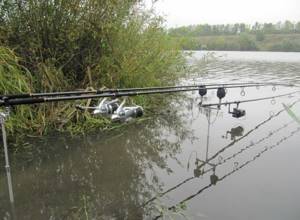
I use fishing line in two sizes - 0.35-0.4 for difficult conditions, 0.29 for normal conditions. I prefer green and dark tones. Shock leader – braided cord 0.35 mm. We always hope to fight against a big and strong opponent. Often fishing takes place in difficult conditions. For these purposes, I choose rods with 3.5 lb test and a fast universal action. I will not hide that for many years I have been a fan of English classics: Leon Hoogendyck, Rod Hutchinson. The Leon Hoogendijk Millennium Gold rod is my faithful friend on most trips. I often use stands as stands: I think they are more versatile for wild fishing. Of course, if the ground allows. Usually fishing occurs in 2-3 different places at the same time. It is very convenient to separate each rod separately.
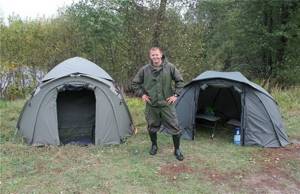
Sessions last 4-5 days, so I try to organize the camp rationally. I use a tent - reliable and quick to assemble for relaxation, and a shelter - as a work place. It is very convenient to have an umbrella in the hot weather; it is compact and provides great protection from the sun.
Additional services
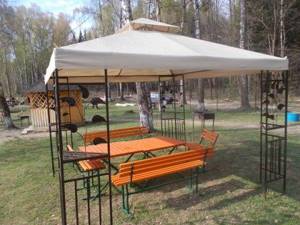
The time spent on the territory of the forest lake will be remembered for a long time: productive fishing, beautiful scenery, fresh air.
Not far from the lake there is a forest where you can take a walk, pick mushrooms, and relax your soul.
This is a good place for a family vacation: children and women are not charged a fee; if fishing takes place with their participation, the caught catch is also weighed and paid for.
Unfortunately, there are no discounts, but it is possible to get an annual subscription or take it for six months, which is very profitable financially.
In addition to fishing, there are all conditions for a family picnic or corporate leisure. On the territory of the club there are comfortable gazebos, cozy houses, barbecues, and a bathhouse.
Cost of additional services:
- renting a place for a corporate event: a large gazebo, tables, barbecues (by agreement with the administration);
- baking fish on coals or smoking (150 rubles per kg);
- cleaning of the catch (50 rubles per piece);
- rent a gazebo (1000 rubles);
- rent an equipped fishing rod for 200 rubles (with a deposit of 2000 rubles);
- a carp landing net for rent will cost 200 rubles;
- fish tank rental 100 rubles;
- The grill can also be rented for 200 rubles.
The “Wild Carp” club has a large assortment of bait, all kinds of baits, and fishing necessities (at an affordable price).

